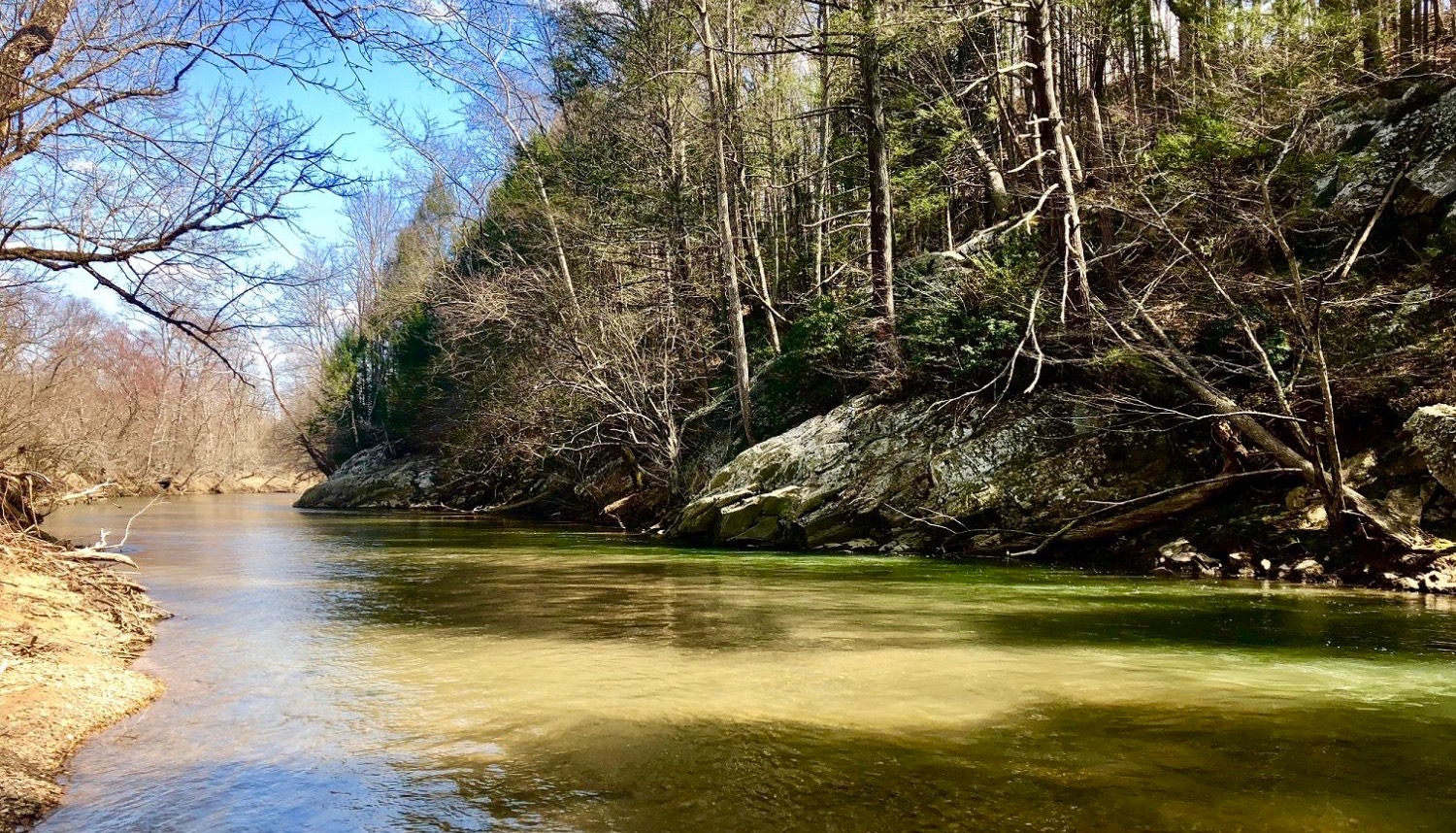Actually, 98 of Them
By Scott Howson
Most people don’t think about this, probably, but our part of the world is defined by its rivers. Dozens of small streams flow out of the mountains, or from the springs that emerge in the foothills, joining together as they head east toward the Chesapeake, forming the rivers that carve our state into distinct regions. You can’t go in any direction without hitting one, and without them our world would be a very different place, with a very different history.
If you head south, for example, just inside Spotsy County you cross the Ni, then the Po, the Ta and the Mat. As they flow east the Mat and the Ta join together to form the Matta, and the Po and the Ni join to form the Poni. Then those two, the Matta and the Poni, join in Caroline County near Woodford to form the Mattaponi, which, further east at West Point joins with the Pamunkey to form the York. The Pamunkey is the child of the North and South Anna Rivers, which you also cross on your southbound trek. They flow out of piedmont marshes in Louisa County.
Heading further south you hit the James, an old river that has somehow found a path through the mountains, collecting several smaller rivers as it flows: the Jackson, Cowpasture, Maury, Hardware, Slate, Rockfish, Tye, Rivanna, and the Willis, before becoming tidal at Richmond. From there the James heads through what looks on the map to be the dismembered intestines of former channels as it picks up the Appomattox and the Chickahominy, then gathers the Back River at Jamestown Island, and on into Hampton Rhodes, an indefinable little quirk of geography where the Pagan, Elizabeth, Hampton, Warwick, Nansemond, and Lynnhaven join in as the James empties into the mouth of the Chesapeake Bay.
About 20 years ago, looking for an excuse to travel the back roads of the East Coast, my wife Sandy and I decided to try to visit every river that flows into the Chesapeake Bay. I figured there were about a dozen or so. There are 98. But we got them all. We traveled through Pennsylvania, got the legendary Conestoga in Lancaster, and went as far north as Cooperstown, NY, to get the headwaters of the Susquehanna; as far east as Delaware for the Nanticoke; and into West Virginia for the western tributaries of the Potomac: the Cacapon, Little Cacapon, Savage, and the branches of the Shenandoah.
Interesting fact. The James River is formed at Iron Gate (Alleghany County, VA) by the union of the Jackson and Cowpasture Rivers. If you follow the Cowpasture west and north further up into the mountains you find its source in eastern Highland County, VA. The Potomac is formed at Harpers Ferry, WV, by the union of the Shenandoah and the Upper Potomac (composed of the North Branch, and the North and South Forks of the South Branch). If you follow the furthest-reaching tributary, the South Fork of the South Branch of the Potomac, you’ll end up at its source, also in eastern Highland County, VA. I think that’s cool. Two major rivers coming from different sides of the same mountain.
The rivers of the Eastern Shore, those that flow west into the Chesapeake, include my two favorite river names: the Transquaking and the Chicamacomico. Also the most interesting: the Wye East River, which actually crosses Skipton Creek on its way to the Bay. Rivers do not cross creeks in the real world, but there you are. If you’re ever wandering around Maryland’s Eastern Shore south of Cambridge (on the Choptank) and Easton (on the Tred Avon) you really should take a drive into the Blackwater National Wildlife Refuge. It’s miles and miles of grassy marsh as far as you can see, and for much of it the road is only a foot or so above the water. Definitely worth visiting.
Oddest river? The Honga, really just a gouge into the shoreline that coincidentally parallels a string of offshore islands, roughly defining a channel about 50 yards wide and a few miles long. It probably feels like a river if you’re on it, but it doesn’t come from, or go to, anywhere.
And of course back here at home there’s the Rappahannock. Coming out of the eastern slopes of the Blue Ridge, the Rappahannock incorporates the Rose, Hazel, Robinson, and Jordan rivers before taking in the Rapidan (which has already taken in the Conway and the South), at the confluence just west of Fredericksburg. I took a drive several years ago up to Flint Hill, just this side of Front Royal, to visit the Jordan. I had trouble finding it until, studying my topo map, I figured out that the ditch running through someone’s yard was it. Looked like someone just forgot to turn off the garden hose. Rivers are funny like that. They come in all sizes and personalities.
East of Fredericksburg the Rappahannock is tidal to the Bay, picking up only the Corrotoman River down in Lancaster County, just a bit before emptying into the Chesapeake near Deltaville. The Corrotoman is itself more of a bay than a river, as many so-called rivers are in the tidal sections, but it hosts the Merry Point Ferry so I’ll let it stand. There are a surprising number of river ferries in Virginia and Maryland, and we don’t mind going out of our way to ride any we can. I took my bike across White’s Ferry on the Potomac when I pedaled the 182-mile C&O Canal trail from Cumberland, MD, into Georgetown, DC, about 15 years ago. I took five quiet days to follow the Potomac from the mountains to DC, and spent one entertaining night above a bar in Paw Paw, WV. But I was younger then, and that’s a story for its own time.
Past the James, rivers don’t flow into the Bay, but generally southward. The Holston and Clinch flow into Tennessee and the Roanoke into North Carolina, for example. But there’s one river that goes its own way. The New River comes out of North Carolina heading north through Virginia into the Allegheny highlands, to continue west across West Virginia, joining into the Ohio River at Point Pleasant. The Ohio, taking a southwest path atop Kentucky, joins the south-bound Mississippi at Cairo, IL, then flows down past New Orleans to the Gulf of Mexico. The New River is said to be the oldest river in, I think, North America.
I was born and raised in New Orleans, and it feels good to know there’s a connection between my birthplace and my chosen home here in Virginia. Drop an acorn in the New River near Radford and eventually it’ll end up in South Louisiana. Our house in New Orleans was only a hundred yards or so from the Mississippi, so I spent much of my youth sitting on the levee there, sketching the ships that passed by, or rummaging along the riverbank for odds and ends. You’d be surprised what we’d find. I figured the stuff was tossed overboard from the ocean-going ships that anchored at the foot of our street. There was always enough lumber washed down from who knows where to build whatever clubhouses my friends and I wanted to build. Even as a boy I was never tempted to swim or fish in this muddy, powerful water. We did build a raft once, but my dad caught us before we got it in the water. I was grounded for a month.
These days, though, Sandy and I often walk downtown to the Rappahannock just to sit and watch it flow by. And for the birds. I often think of the many hikes we’ve taken up in the mountains, and the cold, sweet, crystal water (which I’d gladly drink by the handful), that seeps out of the rocks and dances down the hillsides toward Fredericksburg. I think of our drives toward the Bay in search of seafood, alongside the river as it leaves here heading east, growing ever wider, slower, browner, and saltier as it nears the Chesapeake and eventually is no longer a river, but an inevitable, indistinguishable piece of the Bay. Surely it’s a metaphor for something, but I’m content to think that’s just what rivers do.
***
Scott Howson is a retired graphic artist and former vice mayor of Fredericksburg, VA, who now spends his time writing stories, recording music, building furniture, playing with his grand kids, and exploring the countryside with his best friend, Sandy.


